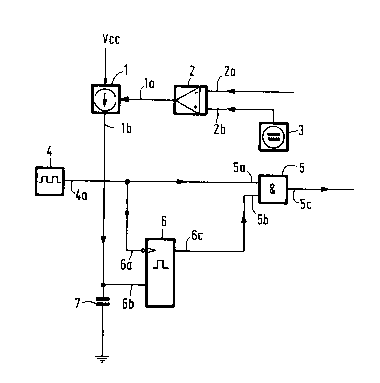Une partie des informations de ce site Web a été fournie par des sources externes. Le gouvernement du Canada n'assume aucune responsabilité concernant la précision, l'actualité ou la fiabilité des informations fournies par les sources externes. Les utilisateurs qui désirent employer cette information devraient consulter directement la source des informations. Le contenu fourni par les sources externes n'est pas assujetti aux exigences sur les langues officielles, la protection des renseignements personnels et l'accessibilité.
L'apparition de différences dans le texte et l'image des Revendications et de l'Abrégé dépend du moment auquel le document est publié. Les textes des Revendications et de l'Abrégé sont affichés :
| (12) Brevet: | (11) CA 1291798 |
|---|---|
| (21) Numéro de la demande: | 1291798 |
| (54) Titre français: | MODULATEUR D'IMPULSIONS EN DUREE |
| (54) Titre anglais: | PULSE-WIDTH MODULATOR |
| Statut: | Périmé et au-delà du délai pour l’annulation |
| (51) Classification internationale des brevets (CIB): |
|
|---|---|
| (72) Inventeurs : |
|
| (73) Titulaires : |
|
| (71) Demandeurs : |
|
| (74) Agent: | KIRBY EADES GALE BAKER |
| (74) Co-agent: | |
| (45) Délivré: | 1991-11-05 |
| (22) Date de dépôt: | 1987-06-04 |
| Licence disponible: | S.O. |
| Cédé au domaine public: | S.O. |
| (25) Langue des documents déposés: | Anglais |
| Traité de coopération en matière de brevets (PCT): | Non |
|---|
| (30) Données de priorité de la demande: | ||||||
|---|---|---|---|---|---|---|
|
ABSTRACT:
The pulse-width modulator described herein comprises a
square-wave generator, a retriggerable monostable multivibrator, a
gate circuit and a controllable current source, having a capacitor
as a timing element for the multivibrator. If the modulator is
assembled from standard building blocks in CMOS-technology and
several external components, its power dissipation will remain
below 10 mW. If completed by a variable-gain amplifier - likewise
carried out in CMOS-technology - and a reference voltage source,
the pulse width modulator can be advantageously used in the
control circuit of a clocked direct voltage converter. Then the
internal losses of a direct voltage converter constructed thus
will still remain below 25 mW.
Note : Les revendications sont présentées dans la langue officielle dans laquelle elles ont été soumises.
Note : Les descriptions sont présentées dans la langue officielle dans laquelle elles ont été soumises.

2024-08-01 : Dans le cadre de la transition vers les Brevets de nouvelle génération (BNG), la base de données sur les brevets canadiens (BDBC) contient désormais un Historique d'événement plus détaillé, qui reproduit le Journal des événements de notre nouvelle solution interne.
Veuillez noter que les événements débutant par « Inactive : » se réfèrent à des événements qui ne sont plus utilisés dans notre nouvelle solution interne.
Pour une meilleure compréhension de l'état de la demande ou brevet qui figure sur cette page, la rubrique Mise en garde , et les descriptions de Brevet , Historique d'événement , Taxes périodiques et Historique des paiements devraient être consultées.
| Description | Date |
|---|---|
| Lettre envoyée | 2005-01-04 |
| Le délai pour l'annulation est expiré | 2004-11-05 |
| Inactive : Renversement de l'état sera réputé périmé | 2004-01-27 |
| Lettre envoyée | 2003-11-05 |
| Lettre envoyée | 2003-11-05 |
| Inactive : Lettre officielle | 1997-10-17 |
| Inactive : Lettre officielle | 1997-10-17 |
| Inactive : Transferts multiples | 1997-09-26 |
| Inactive : Transferts multiples | 1997-09-26 |
| Accordé par délivrance | 1991-11-05 |
Il n'y a pas d'historique d'abandonnement
| Type de taxes | Anniversaire | Échéance | Date payée |
|---|---|---|---|
| TM (catégorie 1, 6e anniv.) - générale | 1997-11-05 | 1997-09-30 | |
| TM (catégorie 1, 7e anniv.) - générale | 1998-11-05 | 1998-09-24 | |
| TM (catégorie 1, 8e anniv.) - générale | 1999-11-05 | 1999-09-20 | |
| TM (catégorie 1, 9e anniv.) - générale | 2000-11-06 | 2000-09-15 | |
| TM (catégorie 1, 10e anniv.) - générale | 2001-11-05 | 2001-09-20 | |
| TM (catégorie 1, 11e anniv.) - générale | 2002-11-05 | 2002-09-19 |
Les titulaires actuels et antérieures au dossier sont affichés en ordre alphabétique.
| Titulaires actuels au dossier |
|---|
| LUCENT TECHNOLOGIES INC. |
| Titulaires antérieures au dossier |
|---|
| THOMAS RIEDGER |